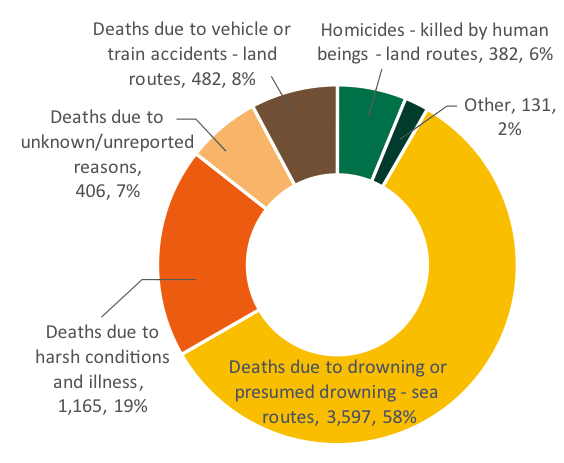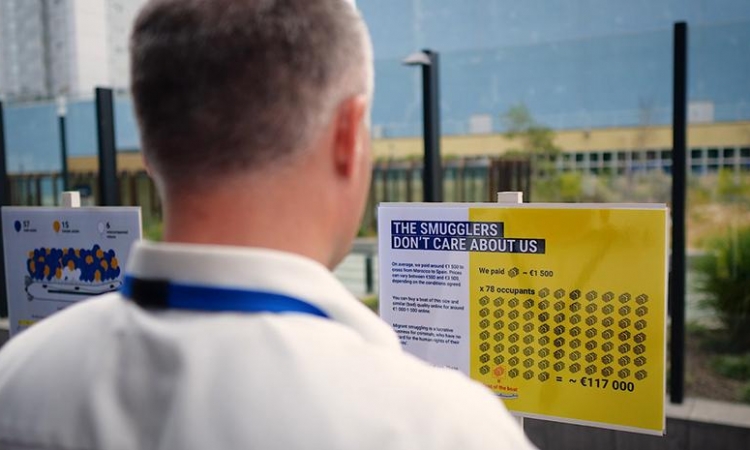From a legal point of view, smuggling of migrants is a criminal offence that relates to facilitating the passage of irregular migrants across an international border for profit. Migrant smuggling is a crime preying on people’s dreams of a better life. But the most serious crime committed during smuggling of migrants may not be the smuggling itself. In all smuggling routes, the lives of migrants are often under threat. While in some cases, people who facilitate border crossing are harmless to the migrants, some smugglers are unscrupulous in their pursuit of profit.
As reported in more detail in the regional chapters of this report, along some smuggling routes, smugglers are directly involved in mass killings. In and around some smuggling hubs and departure areas for maritime routes, systematic torture of migrants, extortion, and various forms of exploitation have also been widely reported. This makes smuggling of migrants a deadly criminal business.
Risks of death: migrants put on precarious path
Dangerous transportation modes along with difficult terrain and unfavourable weather are key factors contributing to the high human costs of smuggling. Substandard vehicles and vessels as well as risky travel arrangements are reported along most smuggling routes. Smugglers may force migrants to use overcrowded, cramped or faulty transportation, often without sufficient fuel, safety equipment or water. These decisions illustrate the smugglers' disregard for the health and well-being of migrants.
Number of migrant fatalities recorded by IOM globally, by cause of death, 2017 (n=6,163)

The International Organization for Migration monitors migrant fatalities worldwide; generating records of fatalities by geographical location and cause of death. According to this data, most migrant deaths are due to drowning while attempting to cross the Mediterranean. Out of a total 8,189 recorded deaths in 2016, 3,832 (46%) took place in the Mediterranean. While this data can give a general sense of where most migrant fatalities seem to occur, IOM indicates that the data only represent a minimum estimate of the total number of fatalities, as many deaths remain unrecorded.
Among the different routes for smuggling by sea, the Mediterranean routes are the most deadly, with more than 10,000 migrant fatalities since 2014. The Central Mediterranean route accounted for 91% of the deaths recorded in the Mediterranean in 2017, and 89% of those recorded in 2016.
Two key reasons can explain why there are more deaths along this route than others. For one, this is a very long and busy smuggling route; a large number of migrants are smuggled along the Central Mediterranean route, which covers an area that is larger than for many other widely used sea routes. A typical journey along this route may be 300 kilometres long, compared to some 30 kilometres between the Turkish coast and some Greek islands, or the northern coast of Morocco and Spain. This means that there is a large number of people who are exposed for a long time to the risks of the high seas.
The second reason is the ruthless behaviour of smugglers active along this route. With scant regard for migrant safety, they arrange travels in often unseaworthy, crowded and inadequate vessels during seasons when weather conditions are bad. In general, the summer months - June to August - are safer for attempting the Mediterranean Sea crossing, as the sea is quieter. During these months, on average, some 2-3% of the migrants attempting to use the Central Mediterranean route have lost their lives. However, since 2015, many migrants have started to board vessels in early spring or late autumn. As a consequence, more fatalities have been recorded over the last three years. Springtime crossings have resulted in a peak of 7-8% of the migrants dying while attempting to cross from North Africa to Italy.
Drowning is a constant risk for migrants and refugees smuggled not only in the Mediterranean sea, but also in the Red Sea and the Arabian Sea, in the Bay of Bengal and the Andaman Sea. The unscrupulousness of smugglers is evident on these routes as well, as there have been reports of smugglers who encourage sea departures during the monsoon season, use substandard vessels and incompetent crew, and who even abandon boats en route.
Sea crossings are generally described by migrants and refugees as horrific experiences. In addition to the common issues of unseaworthy vessels and overcrowding, there is often insufficient food and water and lifejackets are usually not distributed. Moreover, smuggled migrants often have little information about the journey. It is very common that vessels run out of fuel, have engine problems, lose their way at sea or fill up with water.
In some instances, smugglers deliberately kill or endanger the lives of migrants. There are reports of migrants having been pushed out of boats to avoid interception by enforcement authorities. Moreover, migrants may be pushed over- board tens or hundreds of meters from the shores to permit smugglers to avoid detection by land-based authorities. For migrants who are unable to swim, this practice can prove fatal.
A well-known practice used by smugglers is to sabotage vessels to force rescue interventions by coast guards once the vessels are in the sea areas of competence of destination countries. According to international conventions,n coast guards have a duty to intervene to rescue migrants who are at risk in the sea and bring them to safety on shore. Many episodes are recorded of inflatable vessels that have been intentionally punctuated, and wooden vessels set on fire, resulting in migrant deaths.
Dangerous travel conditions are also reported along land smuggling routes. Here, a common smuggling method involves concealing migrants in lorries transporting goods. People smuggled in these conditions are confined in a very small space without ventilation. Deaths have been recorded along many, if not all, land routes reported in this global study.
Challenging weather and terrain conditions are significant causes of deaths along many overland smuggling passages, from jungles to snowy mountains or deserts. The need to avoid detection may compel smugglers to move migrants across more dangerous terrain where the likelihood of death tends to increase.
One of the most dangerous land smuggling passages is heavily used by migrants from Sub-Saharan Africa who move towards North Africa or Europe. In addition to the harshness of overland travel across the semi-arid Sahel and the Sahara desert, smugglers’ carelessness with the health and lives of migrants makes the journey even more risky. Smuggled migrants are regularly transported across the desert in overloaded trucks or pick-ups, often at high speed and with insufficient food and water. Trucks and pick-ups may break down, and passengers who fall ill are reportedly often abandoned by the smugglers in the desert.
Risks of violence and crime: migrants and predators
Throughout their journeys, smuggled migrants are often vulnerable to violence and robbery. Predatory behaviour by smugglers or criminal gangs active along smuggling routes is frequently observed. According to one somewhat dated study, about 65% of the Somalis interviewed along the smuggling route to Southern Africa reported having been beaten up or robbed at least once during their journey to South Africa. Similar risks have been recorded along nearly all routes discussed in this report.
A frequently reported form of violence - which may ultimately result in the death of the smuggled migrant - is extortion for ransom. This practice has been documented along many different smuggling routes. In Africa, it occurs on the route from the Horn of Africa to North Africa, to the Middle East, as well as along routes leading out of West Africa, often carried out by armed groups operating in the parts of the Sahel that are crossed by migrant smuggling routes. Similar risks are also present along routes in the Americas, and along routes from South-West Asia to Europe.In some cases, migrants are held hostage for ransom by the smugglers themselves, however, more frequently, smugglers hand over or sell migrants and refugees to criminal groups upon crossing the border or arrival at major transit hubs.
Massacres and mass graves have been revealed in border areas in some South-East Asian countries and in the Americas. In South-East Asia, smugglers reportedly organise camps where migrants are segregated while ransom money is extorted from their relatives. Extreme brutality and starvation may also be used to put further pressure on families to make the payments.
Female migrants are particularly targeted along many smuggling routes. Sexual violence has been widely documented; from Africa to Europe, to South Africa and to the Middle East. Sexual violence - including rape of boys as well as girls - has been reported during smuggling within the European Union. Sexual assaults of female migrants take place along some routes in the Americas as well. Similar criminal patterns have also been seen along some Asian routes.
Risk of human trafficking and exploitation
Smuggled migrants are at risk of exploitation both during their journey and after their arrival in the destination country. The irregular status that smuggled migrants often have in both transit and destination countries leaves them vulnerable to exploitation and abuse. Not only do smugglers sometimes seek to take advantage of irregular migrants, but corrupt officials and local opportunists may also seek to exploit them. These situations can lead to abuse and human trafficking.
Smuggled migrants are also vulnerable to being trafficked and exploited for forced labour or sexual exploitation, along the route or at destination. A 2015-2016 survey among migrants travelling along the Eastern Mediterranean route indicated that some 7% of the respondents had experienced at least one trafficking or exploitative practice during the journey.
During their journeys, which are often long, smuggled migrants may run out of money to pay for the next smuggling passage. Their urgent need for financial resources can make them vulnerable to being tricked into exploitative situations. Those who have paid for the entire smuggling trip up front - as one package from origin to destination – are also at risk of being exploited at destination, however. Unaccompanied minors and young migrants, in particular, often feel the pressure of paying back the investment made by their families to pay the smugglers for their journey, and this pressure might lead them to working in exploitative conditions. In some cases, these children are also victims of sexual exploitation or involved in illegal activities such as selling drugs. Smuggled migrants may also be forced to transport illicit drugs or participate in the recruitment and smuggling of other migrants, as has been observed for smuggled migrants who have contracted debt to travel to the European Union.
Migrants may also be tricked into human trafficking at the early stages of their journey. They can be made to believe that they are engaging smugglers who will facilitate their journey, but instead, they become victims of trafficking in persons. Human traffickers in origin countries may offer a smuggling package to a desirable destination for a certain fee. The package is said to include land, sea or air transportation, sometimes making use of counterfeit documents or other means. The targeted person accepts the smuggling package, with the idea of paying it back by working at destination. Once at destination, however, the victim is informed that the debt has drastically increased and can only be repaid by working under exploitative conditions. What in the eyes of the migrant was smuggling of migrants was actually human trafficking from the very beginning.
IMAGE CREDIT: EUROPOL

